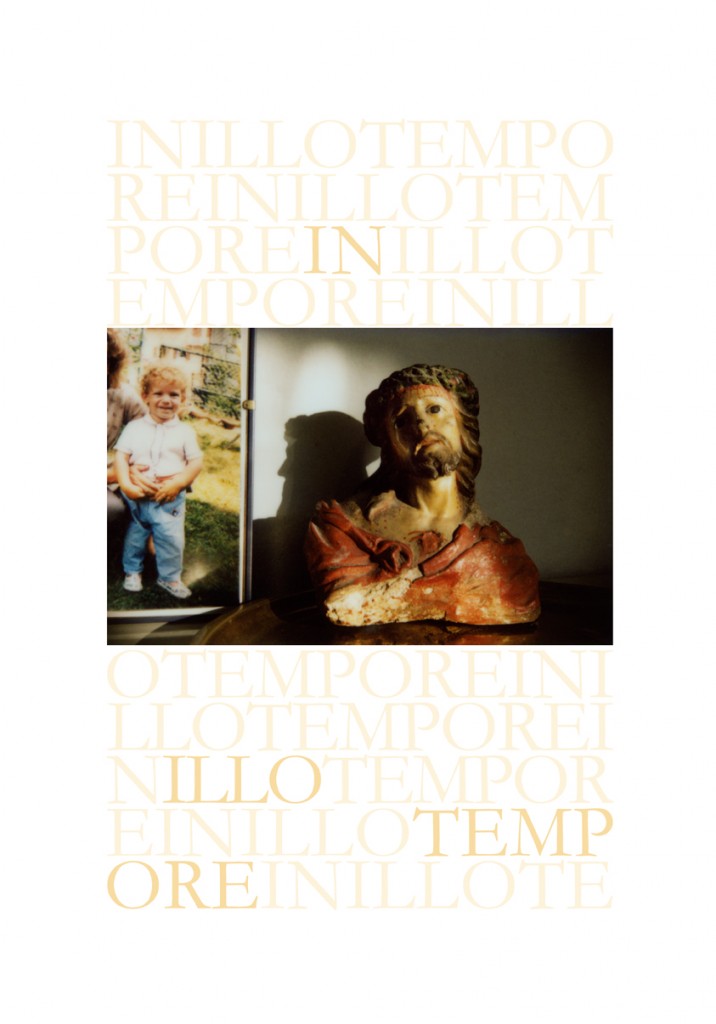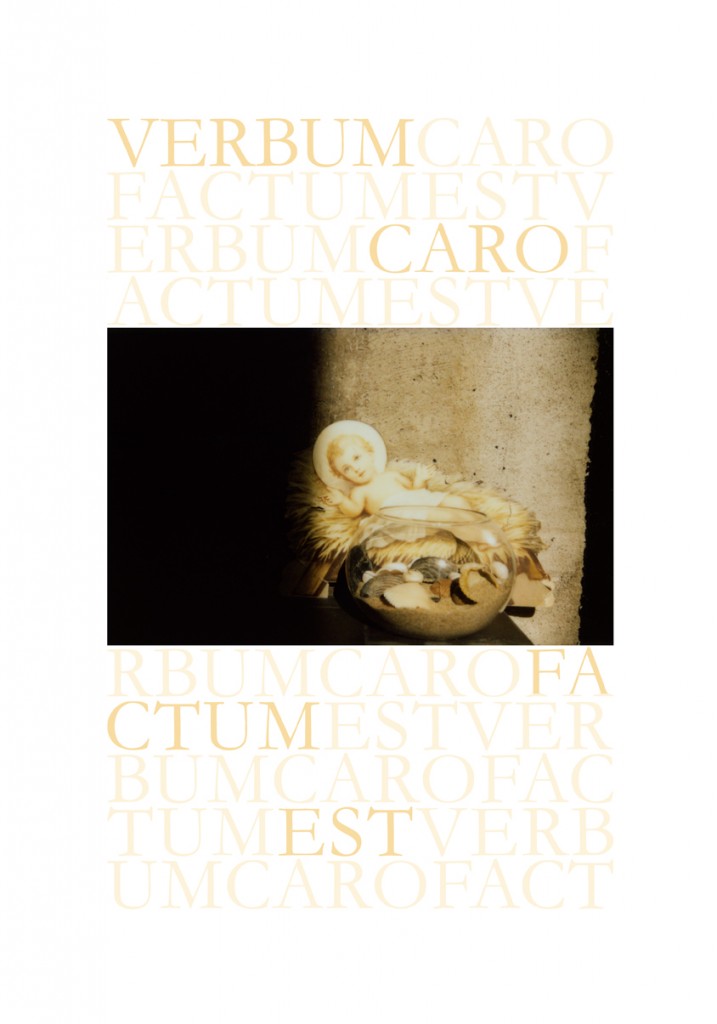Ieri è stato presentato dai cardinali Tettamanzi e Scola una nuova edizione dell’Evangelario ambrosiano illustrato con opere d’arte di artisti contemporanei. Gli artisti sono Nicola De Maria, Mimmo Paladino, Ettore Spalletti, Nicola Saporì, Nicola Villa e Giovanni Chiaramonte (le opere saranno in mostra a Palazzo Reale a Milano da 4 novembre 2011). Desta stupore il fatto che tra essi vi sia anche quest’ultimo visto che si tratta di un fotografo. Se è vero che la fotografia si è spesso confrontata con il tema religioso è anche vero che quasi mai essa sia stata utilizzata come vera e propria arte sacra.
Chiaramonte ha scelto di realizzare otto polaroid che illustrano i tempi liturgici. È curioso anche che abbia scelto proprio il mezzo della polaroid, molto usata da fotografi e artisti ma come mezzo “minore” o meglio “umile”. Ve ne propongo due in anteprima: solo quelle aprono il primo volume del lezionario e che illustrano il “Mistero dell’Incarnazione”.

 In occasione ieri della presentazione il cardinal Angelo Scola ha detto alcune cose interessanti sul rapporto tra arte sacra e arte contemporanea. Cito dal sito di Famiglia Cristiana: «Siamo portati dall’artista a camminare dentro al Mistero, questa è la vera forza del carattere simbolico dell’arte, che dobbiamo riapprendere ad apprezzare abbandonando un certo razionalismo anche nel contemplare un’opera d’arte», ha affermato Scola durante conferenza stampa. «L’arte contemporanea ha una forza liberante perché ti sposta continuamente, ti porta in alto e queste illustrazioni hanno proprio questo compito». Il cardinale ha precisato poi che «il carattere simbolico dell’arte è mediatore di relazione, la stessa che vediamo in Gesù che crede nel Padre, perdona, discute, moltiplica pani e pesci, muore per noi, risorge, insomma si intrattiene con gli uomini». Il nuovo arcivescovo di Milano ha poi lasciato intendere di essere interessato al dialogo con l’arte contemporanea perché essa è «particolarmente adatta ad affrontare la questione della fede, perché risente del travaglio tipico del nostro tempo e dell’eterno problema della fede, quello di mediare la contemporaneità di Gesù con noi, di saltare cioé il grande fossato del tempo come lo chiama Lessing. Per questo tutta l’arte e la scienza sono interlocutori privilegiati della fede», ha concluso.
In occasione ieri della presentazione il cardinal Angelo Scola ha detto alcune cose interessanti sul rapporto tra arte sacra e arte contemporanea. Cito dal sito di Famiglia Cristiana: «Siamo portati dall’artista a camminare dentro al Mistero, questa è la vera forza del carattere simbolico dell’arte, che dobbiamo riapprendere ad apprezzare abbandonando un certo razionalismo anche nel contemplare un’opera d’arte», ha affermato Scola durante conferenza stampa. «L’arte contemporanea ha una forza liberante perché ti sposta continuamente, ti porta in alto e queste illustrazioni hanno proprio questo compito». Il cardinale ha precisato poi che «il carattere simbolico dell’arte è mediatore di relazione, la stessa che vediamo in Gesù che crede nel Padre, perdona, discute, moltiplica pani e pesci, muore per noi, risorge, insomma si intrattiene con gli uomini». Il nuovo arcivescovo di Milano ha poi lasciato intendere di essere interessato al dialogo con l’arte contemporanea perché essa è «particolarmente adatta ad affrontare la questione della fede, perché risente del travaglio tipico del nostro tempo e dell’eterno problema della fede, quello di mediare la contemporaneità di Gesù con noi, di saltare cioé il grande fossato del tempo come lo chiama Lessing. Per questo tutta l’arte e la scienza sono interlocutori privilegiati della fede», ha concluso.
Yesterday was presented by Cardinal Scola and Cardinal Tettamanzi a new edition of the illustrated Evangeliario Ambrosiano with works of art by contemporary artists. The artists are Nicola De Maria, Mimmo Paladino, Ettore Spalletti, Nicola Samorì, Nicola Villa and Giovanni Chiaramonte (the works will be on display at Palazzo Reale in Milan from November 4, 2011). It is surprising that among them there is also a photographer (Chiaramonte). If it is true that photography has often been compared with the religious theme is also true thatit is almost never used as a genuine religious art.
Chiaramonte has chosen to make eight Polaroid illustrating the liturgical seasons. It is curious also that he chose the medium of Polaroid, much used by photographers and artists, but as a “minor” or rather “humble”. Here I show two preview.

 Yesterday, on the occasion of the presentation, Cardinal Angelo Scola remarked some interestingpoints about the relationship between religious art and contemporary art. I quote from the website of the magazine “Famiglia Cristiana”: “We are led by the artist to walk into the mystery, this is the real power of the symbolic nature of art, we must learn again to appreciate leaving a certain rationalism even in contemplating a work of art” , Scola said during a press conference.”Contemporary art has a liberating force because it constantly moves you, takes you up and these pictures have just this task.” The cardinal pointed out that “the symbolic nature of art is the mediator of the report, the same that we see in Jesus he believes in the Father, forgive, discuss, multiplying loaves and fishes, he died for us, rises again, in short, he has relationships with men”. The new archbishop of Milan has also suggested to be involved in dialogue with contemporary art because it is “particularly suited to address the issue of faith, because it reflects the onset of labor typical of our time and the eternal problem of faith, to mediate the contemporary of Jesus with us, that is, to jump “the big gap of time” as Lessing called him. For this reason all the arts and science are privileged partners of faith”, he concluded.
Yesterday, on the occasion of the presentation, Cardinal Angelo Scola remarked some interestingpoints about the relationship between religious art and contemporary art. I quote from the website of the magazine “Famiglia Cristiana”: “We are led by the artist to walk into the mystery, this is the real power of the symbolic nature of art, we must learn again to appreciate leaving a certain rationalism even in contemplating a work of art” , Scola said during a press conference.”Contemporary art has a liberating force because it constantly moves you, takes you up and these pictures have just this task.” The cardinal pointed out that “the symbolic nature of art is the mediator of the report, the same that we see in Jesus he believes in the Father, forgive, discuss, multiplying loaves and fishes, he died for us, rises again, in short, he has relationships with men”. The new archbishop of Milan has also suggested to be involved in dialogue with contemporary art because it is “particularly suited to address the issue of faith, because it reflects the onset of labor typical of our time and the eternal problem of faith, to mediate the contemporary of Jesus with us, that is, to jump “the big gap of time” as Lessing called him. For this reason all the arts and science are privileged partners of faith”, he concluded.

